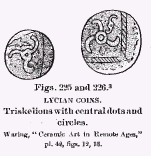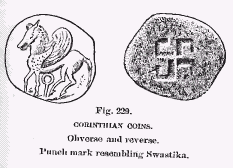|
The Swastika
Dispersion of the Swastika
Page 69
while Lycia, its neighbor,
was a province on the southern side looking toward the island of Rhodes.
The Lydians began coinage by stamping with a punch each ingot or nugget
of gold or silver, or a mixture of them called "Electrum." In
the beginning these ingots were marked upon but one side, the reverse
showing plainly the fiber of the anvil on which the ingot was laid when
struck with the punch. But in a short time, it may have been two hundred
years this system was changed so as to use a die which would be reproduced
on the coin when it was struck with a punch. The lion, bull, boar, dolphin,
and many other figures were employed as designs for these dies. Atheus
used an owl; Corinth, pegasus; Metapontine, a sheaf of wheat; Naples,
a human-headed bull. The head and, occasionally, the entire form of the
gods were employed. During almost the entire first period of nigh three
hundred years the punch was used, and the punch marks show on the reverse
side of the coins. These punch marks were as various as the dies for the
obverse of the coins, but most of them took a variety of the square as
it would present the greatest surface of resistance to the punch. Even
the triskelion of the Lycian coins is within an indented square (figs.
225 and 226). A series of these punch marks is given for demonstration
on pl. 9. A favorite design  was
a square punch with a cross of two arms passing through the center, dividing
the field into four quarters. Most of the punch marks on the coins of
that period were of this kind. These punch marks and the method and machinery
with which they were made are described in standard numismatic works.
(1) was
a square punch with a cross of two arms passing through the center, dividing
the field into four quarters. Most of the punch marks on the coins of
that period were of this kind. These punch marks and the method and machinery
with which they were made are described in standard numismatic works.
(1)
It is believed by the author that
the assertions as to the presence of the Swastika on these ancient coins
is based upon an erroneous interpretation of these punch marks. Fig. 229
shows the obverse and reverse of a coin from Corinth. It is belonged to
the first half of the sixth century B. C. The obverse represents a Pegasus,
standing, while the reverse is a punch mark, said to have been a Swastika;
but, examining closely, we will find there is no Swastika in this  punch
mark. The mars of the normal Swastika consist of straight lines crossing
each other. In this case they do not cross. The design consists of four
gammas, and each gamma is separated from its fellows, all forming together
very nearly the same design as hundreds of other punch marks of the same
period. If each outer arm of this mark is made slightly longer, the Swastika
form disappears and the entire design resolves punch
mark. The mars of the normal Swastika consist of straight lines crossing
each other. In this case they do not cross. The design consists of four
gammas, and each gamma is separated from its fellows, all forming together
very nearly the same design as hundreds of other punch marks of the same
period. If each outer arm of this mark is made slightly longer, the Swastika
form disappears and the entire design resolves
ENDNOTES:
1.
Snowden, "Mint Manual of Coins of all Nations," Introduction,
pp. ix-xiv; Ackerman, "Roman Coins," pl. 14. [Back]
<< Previous Page
Next
Page >>
© 2004-2007 Northvegr.
Most of the material on this site is in the public domain. However, many people have worked very hard to bring these texts to you so if you do use the work, we would appreciate it if you could give credit to both the Northvegr site and to the individuals who worked to bring you these texts. A small number of texts are copyrighted and cannot be used without the author's permission. Any text that is copyrighted will have a clear notation of such on the main index page for that text. Inquiries
can be sent to info@northvegr.org.
Northvegr™ and the Northvegr symbol are trademarks and service marks
of the Northvegr Foundation.
|
> Northvegr™ Foundation
>> About Northvegr Foundation
>> What's New
>> Contact Info
>> Link to Us
>> E-mail Updates
>> Links
>> Mailing Lists
>> Statement of Purpose
>> Socio-Political Stance
>> Donate
> The Vík - Online Store
>> More Norse Merchandise
> Advertise With Us
> Heithni
>> Books & Articles
>> Trúlög
>> Sögumál
>>
Heithinn Date Calculator
>> Recommended Reading
>>
The 30 Northern Virtues
> Recommended Heithinn Faith Organizations
>> Alfaleith.org
> NESP
>> Transcribe Texts
>> Translate Texts
>> HTML Coding
>> PDF Construction
> N. European Studies
>> Texts
>> Texts in PDF Format
>> NESP Reviews
>> Germanic Sources
>> Roman Scandinavia
>> Maps
> Language Resources
>> Zoëga Old Icelandic Dict.
>> Cleasby-Vigfusson Dictionary
>> Sweet's Old Icelandic Primer
>> Old Icelandic Grammar
>> Holy Language Lexicon
>> Old English Lexicon
>> Gothic Grammar Project
>> Old English Project
>> Language Resources
> Northern Family
>> Northern Fairy Tales
>> Norse-ery Rhymes
>>
Children's Books/Links
>> Tafl
>> Northern Recipes
>> Kubb
> Other Sections
>> The Holy Fylfot
>> Tradition Roots

Please Visit Our Sponsors
- Référencement
- Alfaleith.org - Heithni, Viðartrú
- Odin's Journey
- Baman - Iceland/Aboriginal Australia
- Biker's Booty
- Création site Internet Paris
- Pagan T-shirts
- Appartements
- Chalets au Québec
- Logo Designers
- Web Design
- Appartements Montreal
- Espace Bureau Montreal
- London Tours
- Spanish Property Legal Advice
- Multi Pret Hypotheque
- Company Logo Design
- Wiccan T-shirts
- Art Gallery, Painting artists
- free logo design reviews
- Heathen, Heathenism, Norse Pagan
- Logo design by LogoBee
- Pagan Shirts
- Norse Pagan Religion
- Triumph, BSA, Norton, Euro Motorcycles - Accessories
- Logo Maker
- Logo Design - Business Logos, Inc.
- Logo Design - Logo Maker
- Create A Website
- Wiccan Shirts
- Mortgages
- Multi-Prêts Hypothèques
- Viking T-shirts
- Hewlett Packard Ink Cartridges
- Indian Recipes
- Logo Design London
- Logo Design
- Logo Design UK
- Subvention et financement PME
- Heathen T-shirts
- Medical Alert, Emergency response
- orlando hotels
- Slot Machines for Vikings
- Norse Pagan Clothing and Merchandise
- New Homes
- Branding Irons
- Bachelor Degree Online
- Online Degree
- College Degree
- Heathen, Viking and Norse Texts
- Création site Internet
- Montreal Web Design
- Free Dish Network Satellite TV
- Discount ink cartridge & laser cartridge
- DUI Lawyers & DWI Attorneys
- Promotional Products
- Ready-Made Company Logos
- Canadian Art Dealer
- Best CD Rates
- Laser Toner Cartridge
- Logotyper & Grafiska Profilprogram
- Banner Design
- Custom Logo Design
Web site design and coding by Golden Boar Creations
|
|


 was
a square punch with a cross of two arms passing through the center, dividing
the field into four quarters. Most of the punch marks on the coins of
that period were of this kind. These punch marks and the method and machinery
with which they were made are described in standard numismatic works.
(1)
was
a square punch with a cross of two arms passing through the center, dividing
the field into four quarters. Most of the punch marks on the coins of
that period were of this kind. These punch marks and the method and machinery
with which they were made are described in standard numismatic works.
(1) punch
mark. The mars of the normal Swastika consist of straight lines crossing
each other. In this case they do not cross. The design consists of four
gammas, and each gamma is separated from its fellows, all forming together
very nearly the same design as hundreds of other punch marks of the same
period. If each outer arm of this mark is made slightly longer, the Swastika
form disappears and the entire design resolves
punch
mark. The mars of the normal Swastika consist of straight lines crossing
each other. In this case they do not cross. The design consists of four
gammas, and each gamma is separated from its fellows, all forming together
very nearly the same design as hundreds of other punch marks of the same
period. If each outer arm of this mark is made slightly longer, the Swastika
form disappears and the entire design resolves